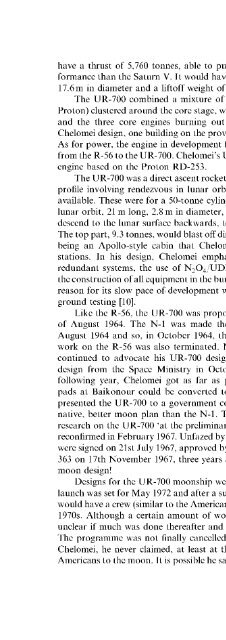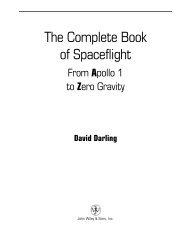Soviet and Russian Lunar Exploration
Soviet and Russian Lunar Exploration
Soviet and Russian Lunar Exploration
You also want an ePaper? Increase the reach of your titles
YUMPU automatically turns print PDFs into web optimized ePapers that Google loves.
have a thrust of 5,760 tonnes, able to put in orbit 151 tonnes, a much better performance<br />
than the Saturn V. It would have been a huge rocket at take-off: 74 m tall,<br />
17.6m in diameter <strong>and</strong> a liftoff weight of 4,823 tonnes [9].<br />
The UR-700 combined a mixture of strap-on rockets <strong>and</strong> fuel tanks (like the<br />
Proton) clustered around the core stage, with the three strap-ons jettisoned at 155 sec<br />
<strong>and</strong> the three core engines burning out at 300 sec. It was a typically ingenious<br />
Chelomei design, one building on the proven engineering achievement of the Proton.<br />
As for power, the engine in development for the R-56, the RD-270, was transferred<br />
from the R-56 to the UR-700. Chelomei's UR-700 had a single third stage, an RD-254<br />
engine based on the Proton RD-253.<br />
The UR-700 was a direct ascent rocket, which Chelomei believed was safer than a<br />
profile involving rendezvous in lunar orbit. Outlines of the UR-700 moonship are<br />
available. These were for a 50-tonne cylindrical moonship with conical top entering<br />
lunar orbit, 21 m long, 2.8 m in diameter, with a crew of two. The moonship would<br />
descend to the lunar surface backwards, touching down on a series of six flat skids.<br />
The top part, 9.3 tonnes, would blast off directly to Earth, the only recovered payload<br />
being an Apollo-style cabin that Chelomei later developed for his Almaz space<br />
stations. In his design, Chelomei emphasized the importance of using multiply<br />
redundant systems, the use of N2O4/UDMH fuels, exhaustive ground testing <strong>and</strong><br />
the construction of all equipment in the bureau before shipping to the launch site. One<br />
reason for its slow pace of development was Chelomei's concentration on intensive<br />
ground testing [10].<br />
Like the R-56, the UR-700 was proposed as a moon project before the decision<br />
of August 1964. The N-1 was made the approved man-on-the-moon project in<br />
August 1964 <strong>and</strong> so, in October 1964, the UR-700 was cancelled <strong>and</strong>, as we saw,<br />
work on the R-56 was also terminated. Never one to give up, Vladimir Chelomei<br />
continued to advocate his UR-700 design, even getting approval for preliminary<br />
design from the Space Ministry in October 1965, much to Korolev's fury. The<br />
following year, Chelomei got as far as presenting designs showing how the N-1<br />
pads at Baikonour could be converted to h<strong>and</strong>le his UR-700. Chelomei formally<br />
presented the UR-700 to a government commission in November 1966 as an alternative,<br />
better moon plan than the N-1. The government politely agreed to further<br />
research on the UR-700 'at the preliminary level' (basic research only) <strong>and</strong> this was<br />
reconfirmed in February 1967. Unfazed by this, Chelomei's blueprints for the UR-700<br />
were signed on 21st July 1967, approved by party <strong>and</strong> government resolution # 1070-<br />
363 on 17th November 1967, three years after the N-1 had been agreed as the final<br />
moon design!<br />
Designs for the UR-700 moonship were finalized on 30th September 1968. First<br />
launch was set for May 1972 <strong>and</strong> after a successful second unmanned flight, the third<br />
would have a crew (similar to the American Saturn V) with lunar l<strong>and</strong>ings in the mid-<br />
1970s. Although a certain amount of work was done on the project in 1968, it is<br />
unclear if much was done thereafter <strong>and</strong> it does not seem as if any metal was cut.<br />
The programme was not finally cancelled until 31st December 1970. In fairness to<br />
Chelomei, he never claimed, at least at this stage, that his UR-700 could beat the<br />
Americans to the moon. It is possible he saw the UR-700 as a successor project to the







